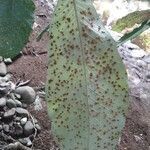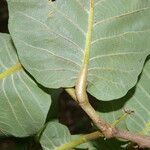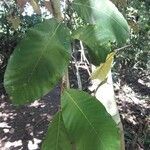Tree to 10 m. tall (or sometimes up to 30 m., according to Standley) with broad stiff blunt, oval or oblong leaves; juvenile foliage, branchlets and inflorescence conspicuously yellowed, very densely hirsutulous with short erect or somewhat matted tawny hairs; branches and upper surface of mature leaves glabrate, the lower leaf-surfaces strongly whitened with a closely felted tomentum; branchlets stout, often 3-6 mm. in diameter at the base of the inflorescence, the bark reddish-brown with inconspicuous pale lenticels. Leaf-blades coriaceous, ovate to elliptic or oblong, broadly rounded at apex, obtuse or (usually) subcordate at base, 5-12 (-15) cm. wide, 6-18 (-25) cm. long, usually 1.4-1.7 times as long as wide, lustrous and glabrous above; lateral veins about 12-15 pairs, widely divergent, the 3-5 proximal pairs much closer together than the others, all raised and forming conspicuous ribs on the lower surface; petioles stout, 5-10 mm. long, 2-3 mm. in diameter; stipules 1-1.5 cm. long, 1-2 cm. wide, linear, acute, appressed, on shoots
A medium sized tree. The leaves are wide and nearly round. The leaves are light grey underneath.



